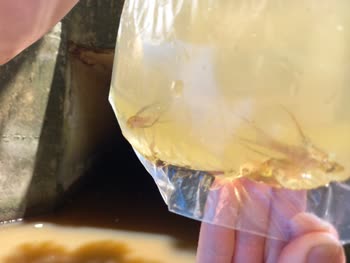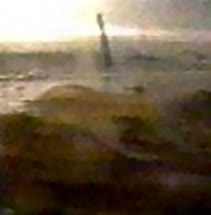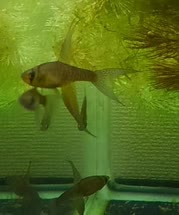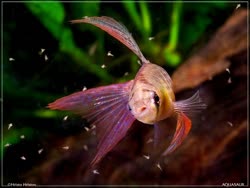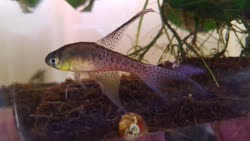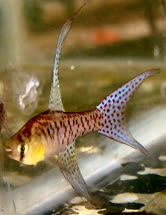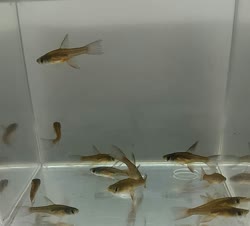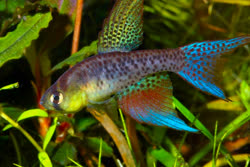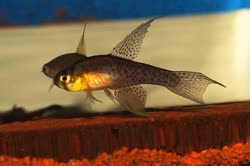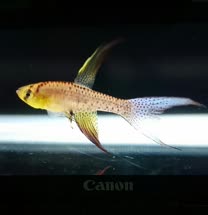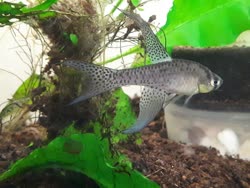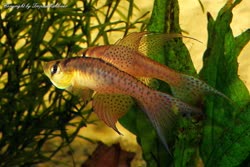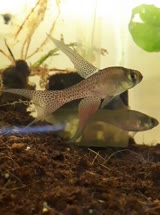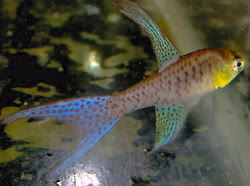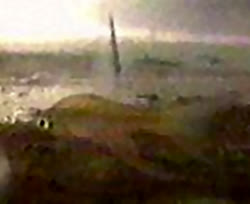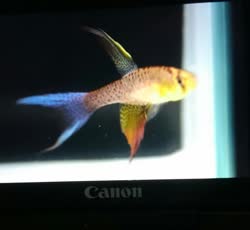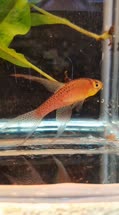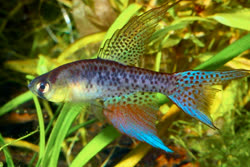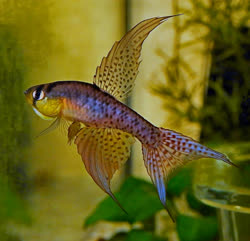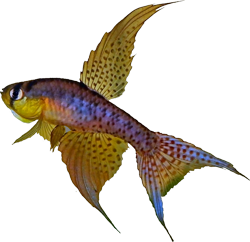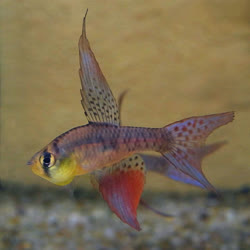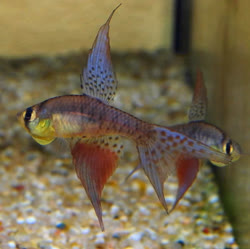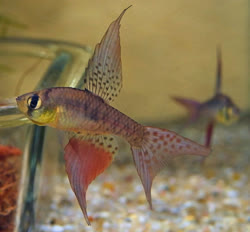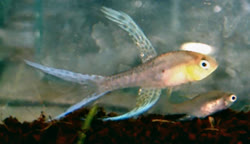|
|
Terranatos dolichopterus Weitzman and Wourms
Diagnosis.-The presence of very elongate, filamentous dorsal and anal fins and of very long, filamentous upper and lower lobes of the caudal fin in adult males immediately separates males of this new species from males of all known species of Austrofundulus, Cynolebias and related genera. The following unique combination of characters will distinguish adult male and female specimens of A. dolichopterus from adults of all other species of Austrofundulus, Cynolebias and related genera. Dorsal fin origin slightly anterior to anal fin origin. Dorsal and anal fin bases approximately equal in length. Caudal peduncle about 25-35% of standard length. Body relatively compressed and not elongate. About 25-27 (usually 26) scale rows between head and caudal fin base, 9 rows between dorsal and anal fin origins, 3-5 rows between lowermost portions of pectoral fin bases and 13 scale rows around caudal peduncle. Scales absent on caudal fin except at base. Austrofundulus dolichopterus appears to be a small or pygmy species not growing much over 30 mm in standard length. Description.-Body measurements expressed as percentages of standard length. Measurements of holotype given first followed by those of paratypes in brackets. Figure in parentheses refers to number of specimens with that particular percentage. Body moderately compressed, not cylindrical, greatest body depth variable, dependent on nutrition and probably age; old, senescent specimens being less robust; 31[23 (1),24(1), 25(1), 27(5), 28(3), 30(9), 31(1)]. Caudal peduncle compressed, proportionately rather long; greatest length of caudal peduncle : 28[25 (3), 26 (3), 27 (7), 28 (6), 29 (3) ]. Least depth of caudal peduncle: 15[12 (3),13(8), 14(7), 15(2), 16(2)]. Upper and lower surfaces of caudal peduncle smooth, not carinate. Profile of top of head a gentle straight slope, sometimes concave at nape especially in senescent or starved specimens. Top of head between eyes flat. Head moderately compressed, width behind eye : 17[16(6), 17(12), 18(3), 19(1)]. Head fairly long : 34[29(1), 31 (2), 32(6), 33 (4),34 (3), 35 (3), 36 (3) ]. Eye diameter usually greater than snout length; snout length : 6[6(2), 7 (10), 8 (9), 9(1)] ; eye diameter : 9[9(2), 10 (15), 11 (4), 12 (1) ]. Postorbital head length considerably greater than eye diameter, postorbital head length: 17[14 (1),15 (1), 16(9), 17(7), 18(3), 19(1), 20(1)]. Dorsal fin origin slightly anterior to anal fin origin. Snout tip to dorsal fin origin in males : 49[49 (4), 50 (2), 51 (3), 52 (1), 53 (1)] and in females : [50(2), 51(2), 53(3), 54(3), 55 (1)]. Snout tip to anal fin origin in males of USNM specimens: 53[52(2),53 (1), 54 (1), 55 (2), 56(3)] and in females : [55(1), 56(1), 57(2), 58(1), 59(1), 60(2),61(1)] ; in males of Stanford specimens : [59(2) ] and in females of Stanford specimens : [62 (2)]. These figures indicate that predorsal and preanal length is usually greater in females and that there also may be population differences in these measurements. Dorsal fin and anal fin with elongate posterior fin rays in both males and females, those of males longer and more variable ; seventh dorsal fin ray often longest and fifth anal fin ray often longest. Length of depressed dorsal fin including streamer in measureable males (first two paratypes are Stanford specimens): 135[77(1), 84(1),101(1), 106(1), 112(1), 115(1), 116(1),118 (1), 122 (1), 124 (1)]; in females (first is only measurable Stanford specimen) : [37 (1),38(1), 39(3), 40(2), 41(1), 42(1), 47(1)]. Length of base of dorsal fin in both sexes : 20[15(2), 16(6), 17(7), 18(4), 19(1),20 (1), 21 (1) ]. Length of depressed anal fin including streamer in males (first two paratypes are Stanford specimens) : 116 [85 (1), 87 (1), 95 (1), 96 (1), 104 (2), 108 (1),113 (1), 117(2), 121 (1)] ; in females (first is only measurable Stanford specimen): [33(1), 34(2), 35(3), 36(1), 39(1)]. Length of anal fin base in males : 23[18 (2), 20(6),21(1), 22(1), 23(1)]; in females : [15(2),16 (2), 17 (7) ]. Pectoral fin elongate, pointed in both sexes,extending beyond origin of anal fin in males and beyond base of pelvics to about anus in females. Pelvic fins elongate,pointed in males, extending well posterior to anal fin origin, reaching about seventh anal fin ray. Pelvic fins in females elongate and pointed, extending posteriorly to between third and fourth anal fin rays. Upper and lower caudal fin lobes extending as long streamers in males, pointed in females. Dorsal fin rays : 15[13 (11), 14 (1), 15 (1) ]. Anal fin rays : 18[14(1), 15(7), 16(9), 17(4), 18(1)]. Pectoral fin rays : 14[13(4),14 (16), 15 (2) ]. Pelvic fin rays 7 in all specimens. Principal caudal ray count 7/7 in all specimens except one with 6/7 and one with 8/7. These variants due to differences in fin ray branching and not number of elements. Scale counts as follows: Lateral series of scales between head and caudal fin base : 26[25(3), 26 (15), 27 (4)]. Scale rows between origin of dorsal and anal fin 9 in all countable specimens (17). Number of scale rows around caudal peduncle 13 in all countable specimens (21). Median dorsal scale row present but median ventral scales in two rows. Gill rakers 2 + 10 in 10 specimens in which a satisfactory count could be made. Teeth in three very irregular rows on lower jaw, about 6-10 teeth in each outer row on each lower jaw ramus. Each tooth conic and slightly recurved inward towards the oral cavity. Teeth of outer row considerably larger than those of inner row ; about one and a half to two times as many teeth in inner rows as in outer row. Premaxillary with three rather irregular rows of teeth, the inner two rows extending along the posterior premaxillary rami. Outermost row contains the largest teeth and consists of four or five large, simple conic teeth. Teeth of inner two rows about half as large as outer teeth and more numerous, about 12-15 teeth in both rows, often many fewer on innermost row. Etymology.-The name dolichopterus is Greek, from dolichos meaning long and pteron meaning wing or fin. Thus the name refers to the distinctive long fins of the males.
|

